Mission: Impact podcast & blog
Build a better world without becoming a martyr to your nonprofit cause
Listen on:
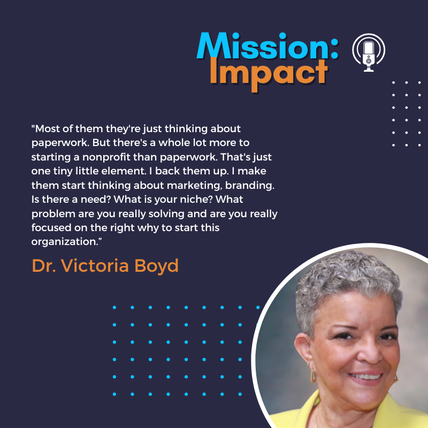 In episode 96 of Mission: Impact, Carol Hamilton and Dr Victoria Boyd discuss
07:34 - Common Misconceptions about Starting Nonprofits what to focus on instead 16:22- The Logic Model as the heart beat of the organization 25:29- **Defining your Unique Value Proposition 27:39 Building shared leadership intentionally Guest Bio:
Dr. Victoria Boyd Author, Trainer, Consultant, and founder of The Philantrepreneur Foundation. Host of the Nonprofit Corner Podcast. Important Links and Resources: The Philantrepreneur Foundation - https://drvictoriaboyd.com/foundation/ Nonprofit Corner Podcast: https://nonprofitcorner.org/home Related Episodes: Episode 17: Program Evaluation with Wendy Wolfe Click "Read More" for a transcript of the interview 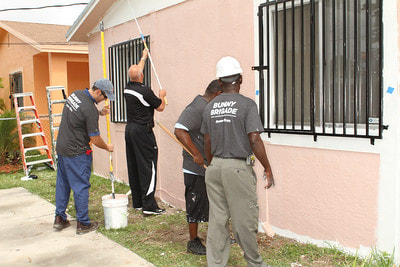 Photo by El Gringo, Miami Habitat for Humanity Photo by El Gringo, Miami Habitat for Humanity Your nonprofit organization is designed for a specific mission with the goal of having an impact in the world. The world will be different in some way because of the work you do. Homeless people are cared for and fed who wouldn’t be otherwise. First generation college students increase their understanding of financial aid so that they can make better decisions about paying for their education. They’d make costly mistakes without you. Emerging leaders in marginalized communities are supported to strengthen their self-awareness and skills so that they can advocate for their community. You undertake the activities and programs with the aim of furthering your mission. Have you taken the time to look at how all the pieces fit together and whether it all adds up? Creating a picture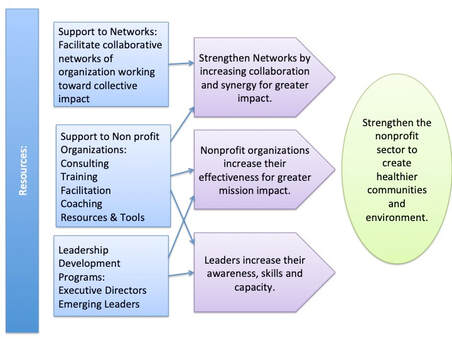 A sample impact map of a capacity building organization. A sample impact map of a capacity building organization. When you create an impact map also known as a logic model, you create a visual representation of what your organization is doing and how it creates the impact you want to have in the world. It makes clear how you leverage resources and organizational capacities to deliver your core strategies to achieve tangible results. By creating an impact map, you are able to create a model that illustrates your beliefs about the change you are trying to make. Identifying assumptions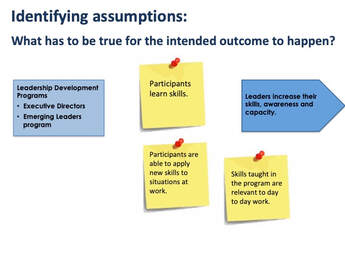 Sample outcomes and indicators. Sample outcomes and indicators. It also can help you uncover the assumptions inherent in your programs and activities. You can also describe what short, medium and long term outcomes you believe result from each program or activity. A good question for identifying assumptions is to ask, “what has to be true for this outcome to happen?” These essentially are the hypotheses embedded in your program design. Are there gaps in logic?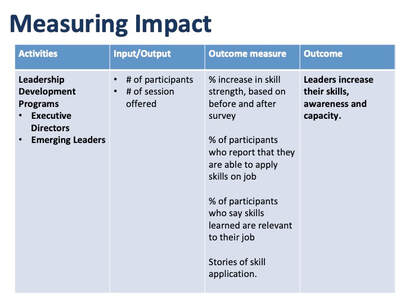 Are you measuring inputs and outputs or outcomes? Are you measuring inputs and outputs or outcomes? Once you have created your map and identified the assumptions inherent with each program, you can consider how you might measure whether you are having the mission impact you are aiming for. An impact map can also uncover gaps in your logic. Creating shared understandingEngaging in the process of impact mapping can be a useful exercise for staff and/or your board. Have small groups create an impact map of your organization. Then compare the maps. Do people envision the same organization? Where are the gaps in knowledge and understanding?
Once you have agreement on your organization’s impact map, take it one step further. Have a conversation about the implications of the map. Ask questions such as:
Think this might be helpful for your organization and would like some help? Inquire about a coaching session. Nonprofit organizations are frequently under pressure to scale up their programs. Scalability and replicability are assumed to be a natural goal. When your program is having a positive impact on the people it is designed for, why would you not want to reach more people? Assumptions Yet there are some big assumptions built into this model. The first is that growth is always good. Our culture worships growth. The economy is only considered healthy when it is growing. A successful career is one moving up in responsibility and scope. A website wants to grow its readership. A podcast wants more listeners. Yet should this always be the goal? Are there alternatives to growing larger in scale? What about going deeper? Are nonprofits like machines?  Another is that nonprofits and their programs are like machines. The basic assumption for being able to scale and replicate is that the program is essentially similar to a widget. You should be able to document the basic elements of a program, train new people to deliver it, create it in a new location and the logic follows that you will then get the same outcomes in the new environment. Can you franchise a nonprofit program? Many nonprofits follow this model -- Habitat for Humanity, City Year, Teach for America. It borrows from the for-profit sector concept of a franchise. Yet can a nonprofit really be franchised? Can you standardize the program and deliver equivalent outcomes in the new arena? Can you really just hit copy and paste when you are dealing with people? Nonprofits as Human Systems  Yet nonprofit programs are not machines. They are inherently human systems. They are built with people with certain skills, talents and abilities to deliver a program. Delivering that program happens in a particular social context. The original participants bring a specific set of circumstances, attitudes and abilities. These all interact to create a unique mix. They have more in common with the uniqueness of snowflakes than widgets or hamburgers. Another analogy that comes to mind is a play - each performance is unique even though the script and the players are the same. Similar, sure, but unique. Usually the goal of these types of program is some type of transformation. To transform people's lives in some way -- Such as building young leaders or increasing educational attainment or creating self-sufficient home owners of low income families. Transformation has little to do with creating new exact copies of the original (widgets, hamburger, t-shirts). What has your experience with scaling? What has worked and what hasn’t? To discuss the strategic issues your organization is facing, inquire about a free coaching call. Some have argued that strategic planning is dead. They argue that the world moves too fast and changes too quickly to make planning meaningful. In today’s “VUCA” – volatile, uncertain, complex and ambiguous – a world characterized by disruption - you just cannot plan for the future. They point out that the practice of long-term planning rose to the forefront during the 50s and 60s when the rate of change was slower. Reactivity 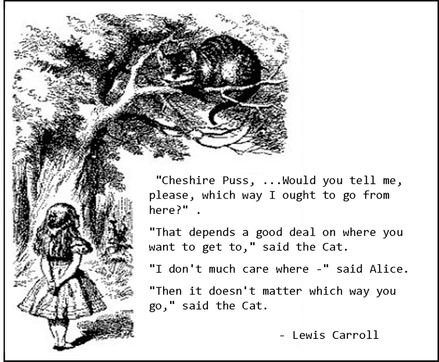 Certainly the rate of change may seem dizzying today. Or perhaps it is the rate and volume of information coming at us that makes it seem like everything is moving too fast (but that is another topic altogether). Yet I would contend that without planning–especially longer term strategic planning or strategic thinking—you leave your organization prone to either business as usual or staying caught in a cycle of reactivity. Predicting the Future? Strategic planning does not enable you to predict the future. I think there is a hidden assumption that in order to do strategic planning effectively you have to somehow know the future. This trips people up. Even futurists cannot accurately predict the future though they spend their professional lives watching trends and making educated guesses. What is strategic planning? I like Allison and Kaye’s definition: “A systematic process through which an organization agrees on and builds key stakeholder commitment to priorities that are essential to its mission and responsive to the organizational environment.” Taking Stock Engaging in the process does enable your organization to step back, consider where you are, where you have been and set some intentions about where you want to head next. Eighty five percent of organizations say that they engage in some sort of strategic planning on a regular basis. It enables you to think about some possible futures and then make decisions about which you would like to see materialize. It does not, obviously, guarantee that you will make it all happen. Setting Intentions & Staying Flexible With flexibility built into both the plan and the process, investing the time in strategic planning sets up your organization for success. By taking stock of both external trends and internal capacities, then setting targets for how you will proactively work towards your mission, you take charge of your future. At the same time, remembering that a plan is just that – a plan – and you will need to adjust it as circumstances change. Using the process as an opportunity to define criteria for how you will make decisions about future strategic opportunities and challenges, you will be better prepared when unexpected things pop up.
Thinking of engaging in a strategic planning process with your organization and want to learn more? Get in touch with me for a complementary coaching session.  An influential volunteer has an idea within your nonprofit organization. They just came back from a conference and heard about an initiative another organization is doing. They think it would be perfect for your organization. When they describe the idea it sounds really intriguing. There is revenue potential and it promises to more fully engage your constituents. Your board and/or senior staff have a conversation about the idea and decide a staff person should put together a business plan. The staff person works on it and the projections look really promising. A staff team is pulled together and their other projects are put on the back burner. As the initiative gets closer to launch, a communications and marketing plan is put together. The initiative launches with lots of internal fan fare. And then…. What went wrong? Crickets. Very few people enroll. Internal discussion concludes that it must be the messaging. Marketing messages are tweaked and a new set of email blasts are designed and scheduled. But interest and enrollment remain low. What went wrong? Lean Start Up The lean start up approach is designed to address this common problem. People falling in love with their own ideas, settling on a wonderful sounding solution without really understanding the problem they are solving for the members or constituents they are trying to serve. Eric Ries created the method with the intent to shift entrepreneurs energy from developing elaborate business plans to ‘getting out of the building” and testing their assumptions with customers. Because it focuses on managing risk and conserving resources it is a good fit for resource poor nonprofits. Build, Measure, Learn 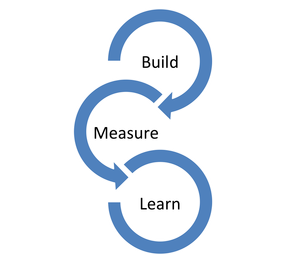 Lean start up helps you answer the question – how do we know what is actually worth working on? Based on three major steps – build, measure, learn, you create a minimally viable product instead of a business plan; identify assumptions by asking the question – what needs to be true for this to be a good idea and then design brief experiments to test these assumptions. Once the experiments are complete and you assess your results and learn from it. Does the evidence point to continuing with your idea as is? Or do you need to pivot? Or do you perhaps need to drop the idea and not expend any further resources on it? Experiments In the example above, instead of proceeding with a business plan and then immediately into launching a project team to build out the idea, the team would instead identify the assumptions inherent in the idea and then design experiments to test these assumptions with customers. Unearthing Your Assumptions Where traditional program design approaches have emphasized careful and lengthy planning, lean start up emphasizes experiments. In the past, new ideas were often based on intuition and anecdotes. Unfortunately these hunches were rarely tested with the audience they were designed for. Instead lean start up moves from an idea to gathering feedback almost immediately. Like the example at the beginning, many organizations have emphasized the ‘big launch’ after a closed or even secret design process. Lean start up focuses on the iterative process – getting feedback quickly and learning from it.
Think this might be a good approach for your organization and want to learn more? Get in touch with me for a complementary coaching session. |
Archives
April 2024

Grace Social Sector Consulting, LLC, owns the copyright in and to all content in and transcripts of the Mission: Impact podcast, as well as the Mission: Impact blog with all rights reserved, including right of publicity.
|
Telephone301-857-9335
|
info[at]gracesocialsector.com
|
Grace Social Sector Consulting, LLC, owns the copyright in and to all content in, including transcripts and audio of the Mission: Impact podcast and all content on this website, with all rights reserved, including right of publicity.
|